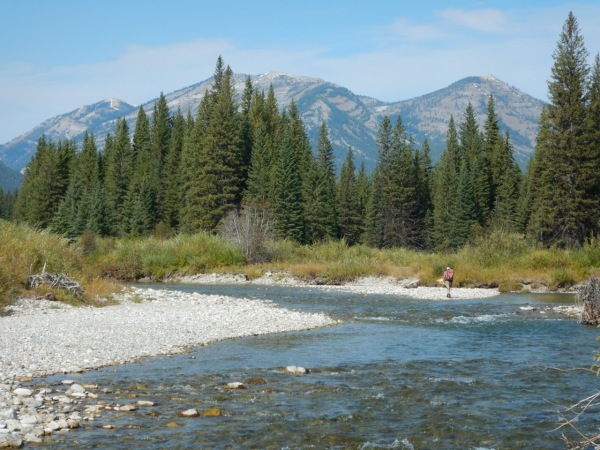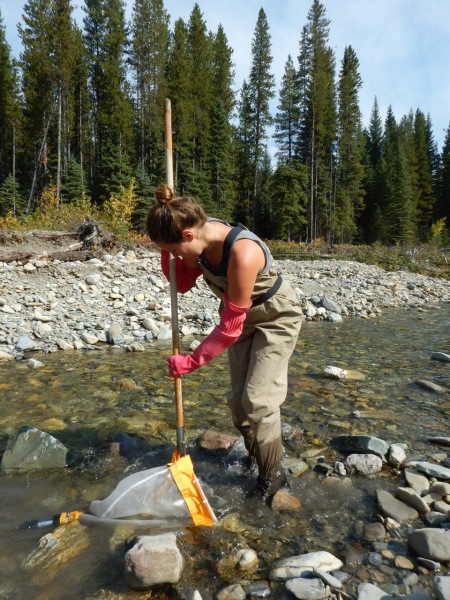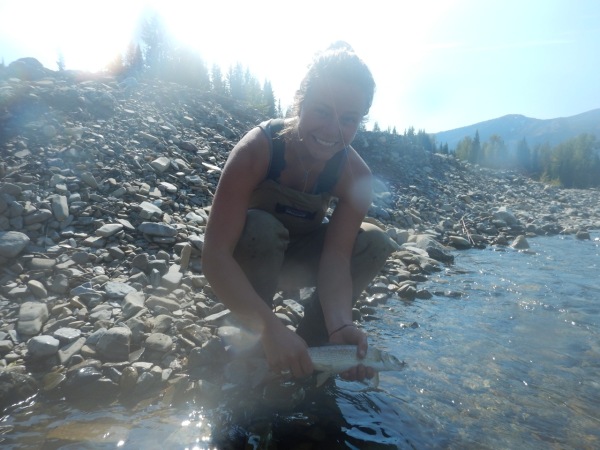Flathead River: Into the Wild Water
Written by Raegan Mallinson, Program Assistant at Living Lakes Canada
Waders on and bug sampling net in hand, I wander through the topaz blue, crystal clear water of the Flathead River. This river is a tributary of the Columbia River, flowing from its headwaters in southeastern British Columbia near the town of Fernie through Washington State to the Pacific Ocean. My gaze stays glued to the river bottom, as I search for homes of the caddisfly – a moth-like aquatic insect. The surrounding scenery of the Canadian Rockies vies for my attention. Around me, this remote river valley has no developments, no paved roads, no buildings and few visitors. A deep sense of relaxation sets in as fresh air fills my lungs and my mind is calmed by the crystal clear waters.

The Living Lakes Canada team is here conducting water quality monitoring in five different river drainages. Our work supports the Flathead Wild campaign goal to expand the Waterton-Glacier International Peace Park and establish a Southern Rocky Mountain Wildlife Management Area in the Flathead Valley. This valley is unmatched in North America for the variety, completeness and density of carnivore species, such as the grizzly bears that live and breed here. Rich in plants, and well-known for its brilliant wildflowers, it’s a mixing zone of plant species from four directions. The Flathead is also a key corridor for animals moving north and south through the Rocky Mountains – all the way from Montana’s Glacier National Park to Canada’s Rocky Mountains.

This is a special place. As we cruise along the hundreds of kilometres of logging roads, we alternate between cut blocks with slash piles the size of small houses and vast expanses of mysterious dense overgrown forests of the valley bottom. In the back our mascot, Shadow the mountain dog mutt, grins showing her appreciation, ears flapping in the wind.
By monitoring different drainages using a protocol developed by Environment Canada, CABIN (Canadian Aquatic Biomonitoring Network) we are able to assess potential threats from logging, fishing and other impacts on this unique freshwater ecosystem. Monitoring in the Flathead is a unique experience. We turn over stream rocks to explore each unique rock or twig caddisfly house. At night we sleep under star-dusted skies with a campfire crackling in the dark. This is a place of rejuvenation, a place to reconnect.

Through engaging community members in monitoring, using the CABIN protocol, the formation of a community-driven stewardship group to protect the Flathead is underway. Together, industry, local government and community members, are working to protect one the most biologically important places on the continent. A place to be protected so that future generations may enjoy, reconnect and experience the vastness of the wild.
If you’re a registered charity or not-for-profit, you can find this year’s Applications and Guidelines for the Loblaw Water Fund at wwfcastg.wwf.ca/waterfund, closing December 15, 2014.
Wildsight and Living Lakes Canada gratefully acknowledge the support of WWF-Canada, Loblaw Companies Limited, and the WC Kitchen Family Foundation on this project.
